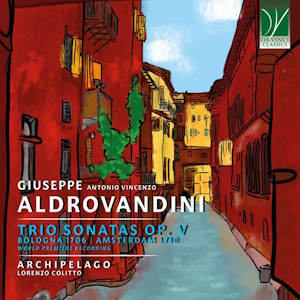
Giuseppe Antonio Vincenzo Aldrovandini (1671-1707)
Trio sonatas Op. V
Archipelago
rec. 2022, Igreja Matriz, Santa Catarina da Fonte do Bispo, Portugal
Reviewed as a stereo 16/44 download from Da Vinci Classics
Da Vinci Classics C00903 [57]
You are excused if you have never heard of a composer with the name of Giuseppe Aldrovandini. His life was short, and a large part of his œuvre, in which music for the theatre takes a central place, has been lost.
Aldrovandini was born in Bologna. His name appears in various forms: in New Grove we find no fewer than four alternatives: Aldovandrini, Aldrovandin, Aldrovandon and Altrobrandino. His first teacher was Giacomo Antonio Perti, who from 1690 to 1696 was maestro di cappella at S. Pietro (and from 1696 until his death in 1756 at S. Petronio). Early in his career, before 1695, two of his oratorios were performed. In that year he became a member of the Accademia Filarmonica, whose principe he was in 1701. It was due to his lifestyle – “intemperate”, according to New Grove, “dissolute”, according to the liner-notes to the recording under review – that he was often suffering from poverty. That lifestyle also caused his death. Whereas New Grove writes that he drowned in the canal port in Bologna “as he was preparing to leave for Venice”, suggesting that is was an accident, Lorenzo Colitto, in his liner-notes, has a different story: “while extremely drunk he exited a tavern on the canal, fell in and drowned.”
It was the end of a career which was largely devoted to opera. His activities in this field are especially notable for the fact that he composed operas in the Bolognese dialect. It is regrettable that this part of his œuvre has not survived. Four of his operas were performed in Naples; two have been preserved complete, and the other two without recitatives. In addition, two comic interludes of one of these operas have also survived. His operas were appreciated, and were still performed after his death.
The importance of opera in his career was such that the rest of his output is very small. It is telling that the article in New Grove entirely focuses on his operas, and other music is not mentioned, let alone discussed. The work-list includes six oratorios; it is unclear whether any of them has been preserved. Aldrovandini published three collections of sacred music (Op. 1 to 3) and two of instrumental works: a set of ten concerti for violin and basso continuo (Op. 4) and the ten trio sonatas which are the subject of the present disc. They were published as his Op. 5 in Bologna in 1706 and were reprinted in Amsterdam in 1710.
They are written, as was common practice, for two violins and basso continuo, but in the Sonata II the slow movements have solo parts for the cello. They are written according to the model of the sonata da chiesa, but Aldrovandini took some liberties in structuring them. Eight of the sonatas are in four movements, in the usual order slow – fast – slow – fast. However, the first movement of the Sonata X has two sections: allegro – adagio. The two remaining sonatas are in three movements. The Sonata V opens with an adagio, which is followed by two allegros. In the Sonata VII two allegros embrace a grave. This indication is also given to the opening movement of five sonatas; the others open with a largo. The slow movements, and especially the first ones, are the most expressive, for instance through the treatment of harmony. Colitto mentions melodiousness and theatrical effects as features of these sonatas, and he is certainly right. They have a “simplicity of form”, as he puts it; they are never dull and include a lot of interesting moments. Also notable, is a fine sense of rhythm.
The latter feature comes off perfectly in these lively performances, which are based on thorough historical research by Archipelago, an ensemble which is new to me, but which I hope to hear again. They have taken some liberties but those seem well within the borders of what is historically justifiable and they make these performances all the more interesting.
Aldrovandini is an unknown quantity, but deserves more interest. I would like to hear the Concerti Op. 4 and some of his sacred music, for instance his Lamentations. Given the nature of the trio sonatas, they may hold some nice surprises. This disc is the perfect way to get to know him.
Johan van Veen
www.musica-dei-donum.org
twitter.com/johanvanveen
Buying this recording via a link below generates revenue for MWI, which helps the site remain free

Contents
Sonata I in G minor
Sonata II in F
Sonata III in D
Sonata IV in C minor
Sonata V in A minor
Sonata VI in F
Sonata VII in D
Sonata VIII in C
Sonata IX in F
Sonata X in B flat

















